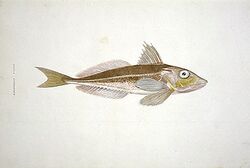Biology:Grey gurnard
| Grey gurnard | |
|---|---|

| |
| Scientific classification Error creating thumbnail: Unable to save thumbnail to destination
| |
| Domain: | Eukaryota |
| Kingdom: | Animalia |
| Phylum: | Chordata |
| Class: | Actinopterygii |
| Order: | Scorpaeniformes |
| Family: | Triglidae |
| Subfamily: | Triglinae |
| Genus: | Eutrigla Fraser-Brunner, 1938 |
| Species: | E. gurnardus
|
| Binomial name | |
| Eutrigla gurnardus | |
| Synonyms[2] | |
| |
The grey gurnard (Eutrigla gurnardus) is a species of sea robin from the family Triglidae native to the eastern Atlantic Ocean, the Mediterranean Sea, and the Black Sea. It is caught as a food fish and is known for producing sounds. It is the only member of the monotypic genus Eutrigla.
Description
The grey gurnard has a large head but does not have a deep occipital groove. There are two dorsal fins, the first has 7–10 spines and the second has 18–20 rays. The anal fin has 17–20 rays, the pectoral fins are short, kust extending as far as the anal fin origin. The scales along the lateral line are slightly larger than the scales covering the body, and have a spiny keel and a toothed rear edge. The breast is naked of scales while the belly is partially covered in scales. The colour of this fish is variable but it is usually greyish-brown, rarely dull red, and tinged with red on its back and flanks. The underside is cream coloured and the back and flanks are usually covered with small white spots. The first dorsal fin has a large, circular black mark.[3] It can grow to a maximum total length of 60 centimetres (24 in), although a more common total length is 30 centimetres (12 in) while the maximum published weight is 956 grams (2.108 lb).[2]
Distribution
The grey gurnard occurs in the eastern Atlantic Ocean from Iceland and Norway south to Morocco, it is found in the North Sea and the southern Baltic Sea as well as off Madeira. In the Mediterranean Sea, its range extends from eastern Spain to Turkey and into the Black Sea.[1]
Habitat and biology
The grey gurnard is a common fish on sandy seabeds but it does occur infrequently on rocky substrates, as well as in mud areas from the shoreline down to 140 metres (460 ft). In the eastern Ionian Sea it has been recorded as deep as 340 metres (1,120 ft). It is a predatory species which feeds on crustaceans, largely shrimps and shore crabs, and small fish, such as gobies, flatfish, young Atlantic herring and sand eels.[2] As with other sea robins, grey gurnards produce sounds. Sound production in this species is often associated with competition for food. Small individuals produce more sounds than larger ones, and emit more "grunts" than "knocks", probably because they more often compete for food by contest tactics whereas larger specimens predominantly scramble for food.[4] In Ireland, the fish has been called the cuckoo fish, knoud, or noud.[5]
Fisheries
Grey gurnards are of commercial importance as a food.[6]
See also
- List of fish of Great Britain
References
- ↑ 1.0 1.1 Keskin, Ç.; Herrera, J.; de Sola, L. (2015). "Eutrigla gurnardus". IUCN Red List of Threatened Species 2015: e.T198754A45901587. https://www.iucnredlist.org/species/198754/45901587. Retrieved 14 March 2020.
- ↑ 2.0 2.1 2.2 Froese, Rainer and Pauly, Daniel, eds. (2019). "Eutrigla gurnardus" in FishBase. December 2019 version.
- ↑ J.C. Hureau. "Grey gurnard (Eutrigla gurnardus)". The fishes of the NE Atlantic and Mediterranean. Marine Species Identification Portal. http://species-identification.org/species.php?species_group=fnam&id=2141.
- ↑ Amorim, M. C. P.; Hawkins, A. D. (2005). "Ontogeny of acoustic and feeding behaviour in the grey gurnard, Eutrigla gurnardus". Ethology 111 (3): 255–269. doi:10.1111/j.1439-0310.2004.01061.x.
- ↑ The Ancient and Present State of the County of Cork. Guy & Co. Ltd. Guy and Co. Ltd.. 1893. p. 231. https://archive.org/details/ancientandprese00socigoog. Retrieved 30 Nov 2013. "knoud fish."
- ↑ "Eutrigla gurnardus (Linnaeus, 1758)". FAO Species Fact Sheets. FAO Fisheries and Aquaculture Department. 2013. http://www.fao.org/fishery/species/2532/en.
External links
Wikidata ☰ Q1107181 entry


